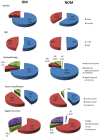CEA as a risk factor in predicting ocular metastasis from colorectal cancer
- PMID: 31892972
- PMCID: PMC6930407
- DOI: 10.7150/jca.31196
CEA as a risk factor in predicting ocular metastasis from colorectal cancer
Abstract
Objective: Colorectal, closely following pulmonary and breast, is the third predilection site of cancer that lead to death all over the world. Ocular metastasis (OM) of colorectal cancer (CRC) is becoming increasingly common and presents a poor prognosis. In this study, we detected some recognized tumor biomarkers and tried to differentiate the discrepancy between CRC patients with and without OM in order to clarify the risk factor for OM in patients with colorectal cancer.
Methods: 1735 patients with colorectal cancer in total from August 2005 to August 2017 were involved in this study. Nonparametric rank sum test and Chi-square test were applied to prescribe whether there were significant differences between OM group and non-ocular metastasis (NOM) group. And binary logistic regression analysis was used to determine the risk factor. Then, we used receiver operating curve (ROC) to assess the diagnostic value of OM in CRC patients.
Results: The incidence of OM in CRC patients was 1.12%. No significant differences were found in gender, age, histopathological type, tumor classification and tumor differentiation between OM group and NOM group. Nonparametric rank sum test approved that OM group had higher serum CEA level compared with NOM group. Binary logistic regression indicated that CEA was a risk factor for OM in colorectal cancer patients (p<0.001). ROC curve showed that AUC of CEA was 0.877. The cutoff value of CEA was 12.45 ng/ml, whose sensitivity is 1.000 and its specificity is 0.877.
Conclusion: Based on our study, CEA was a risk factor of ocular metastasis in colorectal cancer patients.
Keywords: carcinoma embryonic antigen; colorectal cancer; independent risk factor; ocular metastasis.
© The author(s).
Conflict of interest statement
Competing Interests: The authors have declared that no competing interest exists.
Figures



Similar articles
-
The Predictive Value of CA-125 and Hb for Ocular Metastasis in Hepatocellular Carcinoma Patients.Cancer Manag Res. 2022 Dec 5;14:3405-3415. doi: 10.2147/CMAR.S363115. eCollection 2022. Cancer Manag Res. 2022. PMID: 36504761 Free PMC article.
-
The predictive value of high-density lipoprotein for ocular metastases in colorectal cancer patients.Cancer Manag Res. 2019 Apr 29;11:3511-3519. doi: 10.2147/CMAR.S194637. eCollection 2019. Cancer Manag Res. 2019. PMID: 31118776 Free PMC article.
-
Ocular Metastasis in Elderly Lung Cancer Patients: Potential Risk Factors of CA-125, CA-153 and TPSA.Cancer Manag Res. 2020 Mar 10;12:1801-1808. doi: 10.2147/CMAR.S232734. eCollection 2020. Cancer Manag Res. 2020. PMID: 32210622 Free PMC article.
-
Clinical Significance of CYFRA21-1, AFP, CA-153, CEA, and CA-199 in the Diagnosis of Lung Cancer Ocular Metastasis in Hypertension Population.Front Cardiovasc Med. 2021 Sep 14;8:670594. doi: 10.3389/fcvm.2021.670594. eCollection 2021. Front Cardiovasc Med. 2021. PMID: 34595214 Free PMC article.
-
Cancer antigen 153: A risk factor for ocular metastases in patients with breast cancer.Exp Ther Med. 2024 Sep 10;28(5):421. doi: 10.3892/etm.2024.12710. eCollection 2024 Nov. Exp Ther Med. 2024. PMID: 39301252 Free PMC article.
Cited by
-
Predictive models based on machine learning for bone metastasis in patients with diagnosed colorectal cancer.Front Public Health. 2022 Sep 20;10:984750. doi: 10.3389/fpubh.2022.984750. eCollection 2022. Front Public Health. 2022. PMID: 36203663 Free PMC article.
-
The Predictive Value of CA-125 and Hb for Ocular Metastasis in Hepatocellular Carcinoma Patients.Cancer Manag Res. 2022 Dec 5;14:3405-3415. doi: 10.2147/CMAR.S363115. eCollection 2022. Cancer Manag Res. 2022. PMID: 36504761 Free PMC article.
-
CYFRA21-1/TG ratio as an accurate risk factor to predict eye metastasis in nasopharyngeal carcinoma: A STROBE-compliant article.Medicine (Baltimore). 2020 Nov 13;99(46):e22773. doi: 10.1097/MD.0000000000022773. Medicine (Baltimore). 2020. PMID: 33181649 Free PMC article.
-
Serum small RNAs in metastatic colorectal cancer predict response to chemotherapy and characterize high-risk patients.Mol Cancer. 2024 Jun 27;23(1):133. doi: 10.1186/s12943-024-02042-7. Mol Cancer. 2024. PMID: 38937787 Free PMC article.
References
-
- Roncucci L, Mariani F. Prevention of colorectal cancer: How many tools do we have in our basket? Eur J Intern Med. 2015;26(10):752–756. - PubMed
-
- Siegel R, DeSantis C, Jemal A. "Colorectal cancer statistics, 2014". CA Cancer J Clin. 2014;64(2):104–117. - PubMed
-
- World Cancer Research Fund/American Institute for Cancer Research. Food, Nutrition, Physical Activity, and the Prevention of Cancer: A Global Perspective. Washington DC: AICR. 2007. pp. 280–288.
-
- Jemal A, Bray F, Center MM. et al. Global cancer statistics. CA Cancer J Clin. 2011;61(2):69–90. - PubMed
-
- Hess KR, Varadhachary GR, Taylor SH. et al. Metastatic patterns in adenocarcinoma. Cancer. 2006;106(7):1624–1633. - PubMed
LinkOut - more resources
Full Text Sources

